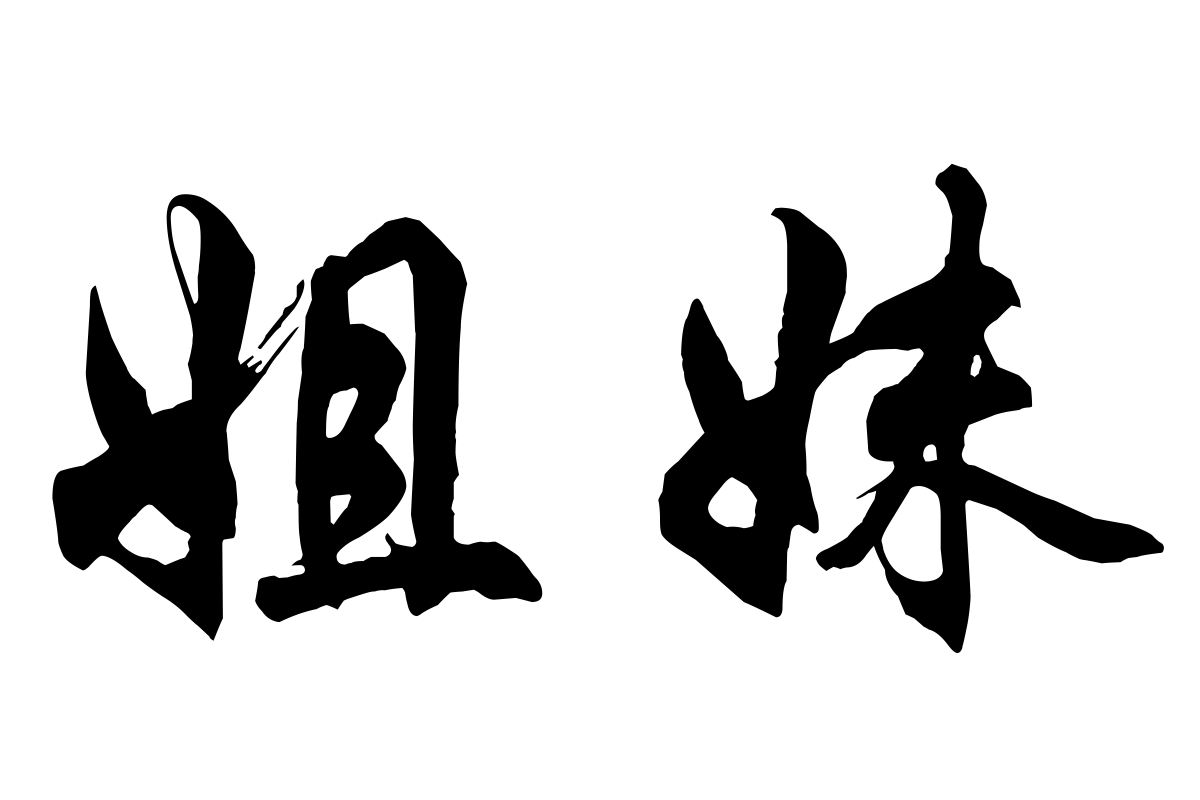Throughout history, the concept of sisterhood has been deeply embedded in various cultures around the world. The sister symbol meaning is a profound representation of unity, loyalty, and emotional connection. Whether in literature, art, or religion, the symbol of sisterhood carries immense significance that transcends generations. Understanding the sister symbol meaning allows us to appreciate the bonds that shape human relationships.
From ancient civilizations to modern times, the sister symbol has been depicted in various forms, each carrying unique interpretations. It represents more than just familial ties; it embodies a shared journey, mutual support, and unconditional love. Exploring the sister symbol meaning reveals how it has influenced cultural narratives and personal relationships.
This article delves into the rich tapestry of the sister symbol meaning, uncovering its origins, cultural significance, and modern interpretations. We will also explore how the sister symbol continues to inspire people today, fostering a sense of community and connection. Let’s embark on this journey of understanding together.
Read also:Whats Elon Musks Sons Name
Table of Contents
- The Origin of Sister Symbol Meaning
- Cultural Significance of Sister Symbols
- Different Variations of Sister Symbols
- Spiritual Meaning of Sisterhood Symbols
- Modern Interpretations of Sister Symbols
- Psychological Impact of Sister Symbols
- Sister Symbols in Art and Literature
- Famous Sister Symbols Around the World
- Sisterhood in Religious Contexts
- Conclusion: Embracing the Sister Symbol Meaning
The Origin of Sister Symbol Meaning
The origins of the sister symbol meaning can be traced back to ancient civilizations where familial bonds were highly revered. In many cultures, the sister relationship was seen as a divine connection, often depicted in myths and legends. For instance, in Greek mythology, the bond between Artemis and Apollo symbolized the protective and nurturing nature of sisterhood.
Historical Context
Historically, the sister symbol meaning was used to represent unity and strength in the face of adversity. Ancient societies often used symbols to depict the importance of family ties, and the sister symbol was no exception. These symbols were carved into stones, painted on pottery, or woven into textiles as a way to honor the bond between sisters.
Archaeological evidence from Mesopotamia and Egypt shows how sister symbols were incorporated into religious rituals and ceremonies. This underscores the deep respect these cultures had for the sister relationship, viewing it as a sacred and enduring bond.
Symbolic Representation in Early Societies
- Ancient Egypt: The Ankh symbol was sometimes associated with sisterhood, representing eternal life and unity.
- Mesopotamia: Clay tablets depicted twin figures as a symbol of sisterly love and protection.
- Greece: The laurel wreath was used to symbolize the bond between sisters in mythology.
Cultural Significance of Sister Symbols
Across different cultures, the sister symbol meaning varies but consistently emphasizes themes of unity, loyalty, and resilience. In African cultures, the Adinkra symbols often include designs that represent sisterhood, emphasizing the importance of community and support among women. Similarly, in Native American traditions, the twin feather symbol is used to signify the bond between sisters.
Read also:Removing Turmeric Stains From Clothes
Cultural Interpretations
In Asian cultures, the sister symbol meaning is often linked to filial piety and respect for elders. For example, in Chinese tradition, the lotus flower is sometimes used as a symbol of sisterhood, representing purity and grace. In Japanese culture, the cherry blossom is associated with the transient nature of sisterly bonds, reminding individuals to cherish every moment together.
These cultural interpretations highlight the universal nature of sisterhood and its significance in shaping societal values. The sister symbol serves as a reminder of the importance of nurturing relationships and maintaining strong familial ties.
Regional Differences in Sister Symbol Meaning
- Africa: The Adinkra symbol "Sankofa" represents the importance of learning from the past to strengthen sisterly bonds.
- Asia: The lotus flower symbolizes purity and the enduring nature of sisterhood.
- Europe: The Celtic knot is often used to depict the interconnectedness of sister relationships.
Different Variations of Sister Symbols
Over time, the sister symbol meaning has evolved, giving rise to various forms and interpretations. These variations reflect the diverse ways in which sisterhood is celebrated and honored across different cultures. Some of the most common variations include:
1. Twin Flames Symbol
The twin flames symbol represents a deep spiritual connection between sisters, often seen as a mirror image of each other. This symbol emphasizes the idea of completeness and balance in sisterly relationships.
2. Heart Symbol
The heart symbol is universally recognized as a representation of love and affection. When used in the context of sisterhood, it signifies the emotional bond and unconditional support between sisters.
3. Knot Symbols
Knot symbols, such as the Celtic knot, are used to depict the unbreakable bond between sisters. These intricate designs symbolize the complexity and depth of sisterly relationships.
Spiritual Meaning of Sisterhood Symbols
From a spiritual perspective, the sister symbol meaning extends beyond physical relationships, encompassing a deeper metaphysical connection. In many spiritual traditions, sisterhood is seen as a divine union, representing the interconnectedness of all beings.
Spiritual Insights
In Hinduism, the concept of "Sahodar" refers to the spiritual bond between sisters, emphasizing the importance of mutual support and understanding. Similarly, in Buddhism, the sister symbol meaning is linked to compassion and empathy, encouraging individuals to cultivate these qualities in their relationships.
These spiritual interpretations highlight the transformative power of sisterhood, encouraging individuals to embrace their connections with others and foster a sense of unity and harmony.
Spiritual Practices Related to Sisterhood
- Meditation: Practicing mindfulness to strengthen sisterly bonds.
- Prayer: Offering prayers for the well-being of sisters and their relationships.
- Community Rituals: Participating in ceremonies that celebrate sisterhood and unity.
Modern Interpretations of Sister Symbols
In contemporary society, the sister symbol meaning has taken on new dimensions, reflecting the changing dynamics of relationships. Modern interpretations emphasize the importance of inclusivity and diversity, recognizing the diverse forms that sisterhood can take.
Modern Perspectives
Today, the sister symbol meaning is often associated with feminist movements, advocating for gender equality and empowerment. Social media platforms have played a significant role in promoting these ideas, allowing individuals to connect and share their experiences of sisterhood.
Artists and activists continue to use the sister symbol as a tool for advocacy, creating works that celebrate the strength and resilience of women. These efforts highlight the ongoing relevance of sisterhood in shaping societal norms and values.
Sisterhood in Digital Spaces
- Online Communities: Platforms where women can connect and support each other.
- Digital Art: Visual representations of sisterhood that resonate with modern audiences.
- Activism: Using the sister symbol to promote social justice and equality.
Psychological Impact of Sister Symbols
From a psychological perspective, the sister symbol meaning plays a crucial role in shaping individual and collective identities. Studies have shown that strong sisterly bonds contribute to improved mental health and emotional well-being. The presence of a supportive sister figure can provide a sense of security and belonging, reducing stress and anxiety.
Psychological Benefits
Research conducted by the American Psychological Association highlights the positive effects of sisterhood on mental health. Participants who reported strong sisterly relationships exhibited higher levels of self-esteem and resilience, indicating the therapeutic value of these connections.
Understanding the psychological impact of sister symbols can help individuals appreciate the importance of nurturing their relationships and seeking support when needed.
Key Psychological Findings
- Improved Mental Health: Strong sisterly bonds contribute to better emotional well-being.
- Increased Resilience: Sisters provide support during challenging times, fostering resilience.
- Enhanced Self-Esteem: Positive sisterly relationships boost confidence and self-worth.
Sister Symbols in Art and Literature
Throughout history, the sister symbol meaning has been a recurring theme in art and literature, inspiring countless works that celebrate the beauty of sisterhood. From paintings to novels, artists and writers have explored the complexities of sisterly relationships, capturing their essence in vivid detail.
Artistic Representations
In literature, famous works such as "The Color Purple" by Alice Walker and "Little Women" by Louisa May Alcott delve into the sister symbol meaning, portraying the challenges and triumphs of sisterly bonds. Similarly, in visual arts, paintings like "The Sisters" by John Singer Sargent capture the intimacy and connection between sisters.
These artistic expressions highlight the enduring appeal of sisterhood and its ability to inspire creativity and reflection.
Famous Artworks Depicting Sisterhood
- "The Sisters" by John Singer Sargent: A portrait of two sisters showcasing their closeness.
- "The Two Sisters" by Édouard Manet: A painting that emphasizes the bond between siblings.
- "Sisterhood" by Frida Kahlo: A surrealist depiction of female solidarity.
Famous Sister Symbols Around the World
Various cultures have their own unique sister symbols that reflect their values and traditions. These symbols serve as a testament to the universal nature of sisterhood and its significance in shaping human relationships.
1. The Ankh Symbol (Egypt)
The Ankh symbol, often associated with eternal life, is also used to represent sisterhood in ancient Egyptian culture. It symbolizes the enduring nature of sisterly bonds and their ability to transcend time.
2. The Twin Feather Symbol (Native American)
In Native American traditions, the twin feather symbol represents the unity and strength of sisterhood. This symbol is often used in ceremonies and rituals to honor the bond between sisters.
3. The Lotus Flower (Asia)
The lotus flower is a common symbol of sisterhood in Asian cultures, representing purity, grace, and resilience. It serves as a reminder of the beauty and strength of sisterly relationships.
Sisterhood in Religious Contexts
Many religions incorporate the sister symbol meaning into their teachings, emphasizing the importance of community and support. In Christianity, the concept of "spiritual sisters" encourages believers to nurture their relationships and offer mutual support. Similarly, in Islam, the sister symbol meaning is linked to the idea of "ukhuwwah," or brotherhood/sisterhood, promoting unity and compassion among believers.
Religious Interpretations
In Judaism, the sister symbol meaning is often associated with the biblical story of Miriam, who played a crucial role in supporting her brother Moses. This narrative highlights the importance of sisterly strength and leadership in religious contexts.
These religious interpretations underscore the universal nature of sisterhood and its ability to inspire individuals to cultivate meaningful connections with others.
Conclusion: Embracing the Sister Symbol Meaning
In conclusion, the sister symbol meaning is a powerful representation of unity, loyalty, and emotional connection. From its historical origins to its modern interpretations, the sister symbol continues to inspire individuals around the world. By embracing the values of sisterhood, we can foster stronger relationships and create a more inclusive and supportive society.
Call to Action
We invite you to reflect on the sister symbol meaning in your own life and consider how you can strengthen your relationships with others. Share your thoughts and experiences in the comments below, and explore our other articles to deepen your understanding of this timeless concept.


